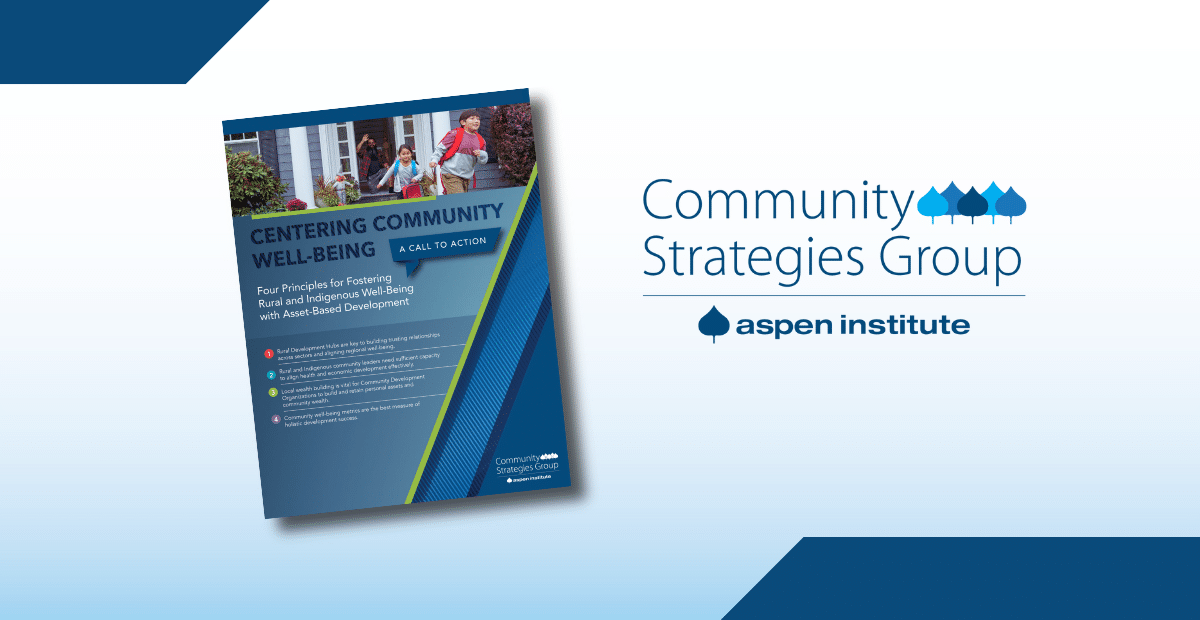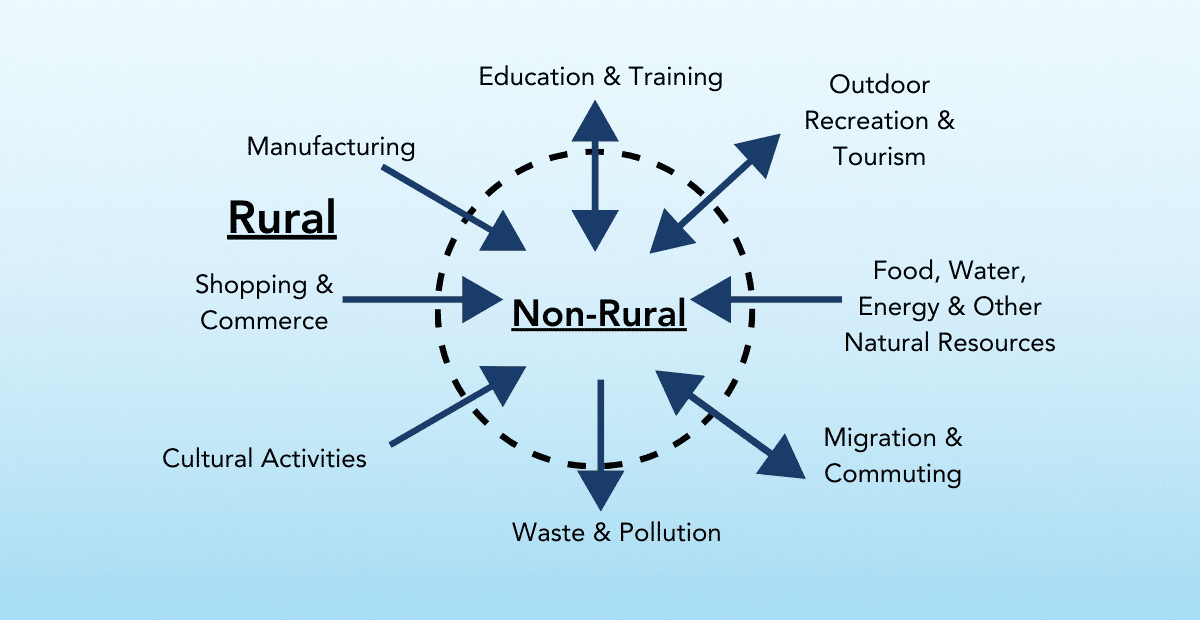Rural champions have traditionally worked on rural health and economic development in separate efforts – the exception being the long-recognized importance of rural hospitals as anchor institutions.
However, we know that strong health outcomes are a key driver of equitable rural prosperity and must be integrated into all aspects of rural development work. One promising method to weave these fields more closely is developing shared data and evidence infrastructure and using that good data to drive cohering strategies.
For several years, our team at Aspen CSG has been working to integrate health into a broader concept of equitable rural prosperity in the Thrive Rural Framework. We’ve also been active in calling attention to the data gap and weaving health and rural development together throughout our work.
In this blog, we’ve synthesized related learnings, insights, and resources from the field to better understand where progress is needed and what wins we all can celebrate.
Join us in reflecting on: What will it take to more closely weave together the fields of health equity and rural development?
Aspen CSG’s work and this learning reflection are grounded in the Thrive Rural Framework, which outlines a future where communities and Native nations across the rural United States are healthy places where each and every person belongs, lives with dignity, and thrives. Based on research and best practices from the field, this framework shows what needs to be true within both a local-level and systems-level theory of change for equitable rural prosperity to occur.
Roadmap
With more than 30 years of work, Aspen CSG has developed a roadmap for this work; from initial frameworks like WealthWorks and Rural Family Economic Success to the recently released Thrive Rural Framework, our work has integrated social determinants of health and health equity into how we approach rural development.
Each building block in the Thrive Rural Framework, for example, has related resources and background analysis grounded in health equity research. And the first publication in our Field Perspective series Rural Development and Rural Health: Trends and Opportunities for Alignment, based on two comprehensive field scans of rural health and rural development and released in 2021, provides a digestible assessment of the state of these two fields and articulates a vision of field alignment will make possible.
“Imagine what contributions to long-term rural community stability, resilience and prosperity might flow from aligning [health and development]…increasing the affordability and availability of reliable, high-speed broadband; robust workforce programs for rural public health nurses, community health workers, and nurse practitioners; and the integration of local leadership in setting priorities and making decisions. Actions in the health sphere might lead to innovations in integrated rural health care, expanded telehealth, distributed care networks, expanded measures of success used by the healthcare field, and regional purchase agreements that support local businesses and minority entrepreneurs.”
(Dabson and Faust 2021)
In addition to sketching out important trends in both fields, Brian Dabson and Victoria Faust, authors of the Field Perspective brief, also identify three big opportunities for aligning health and development:
- Strengthen a shared data and evidence infrastructure and usage to drive cohering strategies. With privacy and data security safeguards in place, closer integration of data and analytic capabilities may lead to a more accurate and nuanced understanding of rural challenges and opportunities. This can lead to better equity-centered metrics – like health and wellbeing relative changes as indicators of development success.
- Focus on measuring rural wellbeing as improvements in multiple community and regional assets. Expanded definitions of wealth and health provide a means of determining progress towards community goals across a range of indicators and can help to assess community change in terms of impact on those assets.
- Integrate and collaborate to improve multiple cross-field outcomes. In order to do this, flexible, integrated funding streams are needed to better encourage and support projects that achieve multiple development and health objectives, and local and regional collaborations across jurisdictions and organizations can share ideas, pool resources, and plan together.
These three opportunities for aligning health equity and rural development provide a roadmap and index for this learning reflection.
First up is resources and field developments related to shared data and evidence infrastructure. Join our mailing list for upcoming blogs on integrating outcomes and collaboration as well as measurement and assets.
Resources to strengthen a shared data and evidence infrastructure and usage to drive cohering strategies across health equity and rural development
Looking for data, tools, or maps that help you explain or explore rural and Native nation health equity and development issues? Aspen CSG’s In Search of Good Data report explored the strengths and weaknesses of many data sets, but since its publication, the field has seen a host of new resources. Try out any or all of these tools:
- Each year, the University of Wisconsin Population Health Institute releases the County Health Rankings and Roadmaps (CHR&R) report, a powerful resource that brings actionable data, evidence, guidance, and stories to support community-led efforts to grow community power and improve health equity. This year’s data included new measures of civic health as well. Last year, Aspen CSG joined CHR&R’s webinar exploring how the Thrive Rural Framework can help communities identify assets, implement strategies, and measure progress to advance rural prosperity, health, and well-being.
- The National Congress of American Indians Policy Research Center is strengthening a shared data and evidence infrastructure on Native nations by tracking federal research priorities, supporting the work of tribes and American Indian/Alaska Native communities, and synthesizing data and information for tribal use. They have valuable resources on research ethics, public health, and tribal data capacity and sovereignty.
- Looking for more? Aspen CSG highlights why tribal sovereignty and Native nation building are key components of public health and development for Indigenous communities and nearby non-Native rural communities.
- Headwaters Economics recently released the Rural Capacity Index, a mapping tool that identifies communities where investments in staffing and expertise are needed to support infrastructure and climate resilience projects. It can help communities advocate for resources and federal and state agencies to more deliberately invest in communities that would otherwise be left behind.
- The Housing Assistance Council (HAC) hosts a Rural Data Portal that provides interactive maps and reports that show the social, economic, and housing characteristics of communities in the United States. Housing is one of the cornerstones of community health, and HAC’s portal allows the user to see housing data alongside other important indicators.
- The Rural Aperture Project, a new Thrive Rural effort produced by the Center on Rural Innovation (CORI), helps provide all those advancing health equity and development — from practitioners to journalists, researchers, philanthropists, and government officials — with accessible data, graphics, and narratives to inform how they can better tell stories, conduct research, distribute resources, make investments, or develop policy that is backed by up-to-date data. To date, CORI has released three related data tools:
- Defining Rural America explores the consequences of how we count and measure rural places
- Who Lives in Rural America (part one) explores how data shapes our shared conceptions of diversity
- Who Lives in Rural America (part two) explores the geography of rural race and ethnicity
- The Urban Institute’s Revisioning Rural America mapping tool builds on the Community Capital asset-based framework to create dashboards for local, state, and federal policymakers, practitioners, and investors to better understand the diversity of rural American communities and therefore make better investments. The dashboard has a plethora of health equity and development metrics.
- The Federal Government provides thousands of potentially useful datasets free of charge via its Data.Gov portal. But access to datasets doesn’t mean that a rural or Native nation community has the capacity to deploy that dataset – or that the data contained in a given dataset reflects rural realities, as Aspen CSG’s In Search of Good Data report shows. USDA’s Economic Research Service has a helpful page that aggregates rural-specific federal data sources, categorized by their content, time period, as well as their geographic coverage. The Health Resources Service Administration’s Rural Health program helps build healthcare capacity and improve health outcomes for rural communities – and they provide a number of potentially useful maps and tools on their website.
- County governments are at the forefront of both public health and economic development. The National Association of Counties’ County Governance Project allows users to explore county-level data and produce reports on a host of important health equity and development variables, including health and human services, infrastructure, public amenities, and more.
- The Rural Health Information Hub provides a large online library of tools and resources as well as data visualizations and maps that could help communities and rural advocates in any number of health equity and development-related work. One tool to check out is the Rural Health Equity Toolkit, containing evidence-based frameworks and promising strategies and resources to support organizations working toward health equity in rural communities across the United States.
- The Rural Health Mapping Tool, a product of the Centers for Disease Control and Prevention (CDC) and NORC, helps researchers, community organizations, and policymakers create county-level maps illustrating the relationship between COVID-19 vaccination coverage rates and other health outcomes, socio-demographic, and economic variables across all counties of the United States. These maps can be used to target resources and interventions and inform efforts in rural places.
- The Robert Wood Johnson (RWJF) Culture of Health Prize honors the work of communities where people and organizations collaborate to advance health, opportunity, and equity for all. While not exclusively rural, every year, the Culture of Health Prize celebrates rural communities, and on their website, there are case study examples of what constitutes a healthy rural or Native nation community that can be a roadmap for other communities seeking similar results. RWJF cares deeply about health equity in rural places and (full disclosure) is a funder of the Thrive Rural effort in which Aspen CSG is active.
Outstanding Questions for the Field
Resources that have the potential to strengthen a shared data and evidence infrastructure and usage have the potential to drive cohering strategies across health equity and rural development. But the learnings and resources above raise new questions:
- How are the fields of health equity and rural development growing and changing as a result of shared data tools? Thanks to the hard work of data scientists at organizations like CHR&R and CORI, we are now able to visualize rural health and development realities together by creating map overlays that can draw on multiple health and development variables. As new mapping tools come online, are they transforming the way health and development practitioners on the ground are doing their work? If so, how and is this making collaboration across these two crucial fields more likely?
- What will it take for rural communities and Native nations to grow the capacity to use data effectively to inform decision-making and investment? Data is a persuasive tool to sway decision-makers, investors, and other systems-level actors, and many of the tools explored above make it much easier for a resource-strapped community to make the case for new or increased investment. But too many communities or rural regions still need added organizational capacity and human capital in order to take advantage of the benefits of good data.
- What will it take for good rural data to influence national rural narratives for the better? The new data tools can illuminate a complex and diverse rural America that explodes myths and stereotypes about who lives and works in rural places and the economies and health situations of those rural regions. But having access to those data realities has not yet transformed how large media outlets cover rural issues, nor has it changed national perceptions of rural.
This reflection was written by Devin Deaton, Action Learning Manager, and the entire Aspen CSG team contributed to its production.
One of the goals of the Thrive Rural effort is to regularly synthesize insights we are learning through our engagements with the wider field of rural prosperity. This blog is part of a series that leans into and synthesizes broader field insights, using the framework as a lens. Not only can we pull together and show commonalities across seemingly disparate topics, but we can also illuminate gaps and areas to improve the Thrive Rural Framework.







